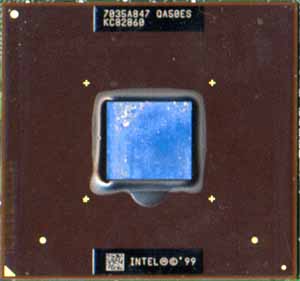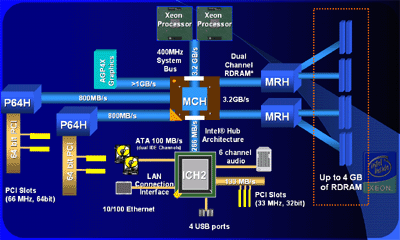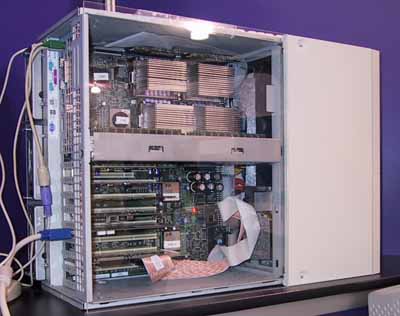Intel Xeon 1.7GHz: King of the High End?
by Anand Lal Shimpi on May 21, 2001 8:00 AM EST- Posted in
- CPUs
A New Platform
When the original Pentium II Xeon made its launch, it did so alongside two new chipsets for the processor: the i440GX and the i450NX. The i440GX chipset was nothing more than a server version of the desktop 440BX chipset with support for twice as much memory. The i450NX chipset was a true server chipset as it supported 64-bit PCI, and quad Pentium II Xeon processors.
The Intel Xeon processor allows history to repeat itself again as it makes its initial debut with nothing more than a server/workstation version of the desktop i850 chipset: the i860 chipset.
The i860 does offer a few more enhancements over the desktop 850, primarily in its support for up to two 64-bit PCI buses alongside a single 32-bit PCI bus.
The 64-bit PCI buses each require a separate chip to be installed on the motherboard, the PCI 64 Hub (P64H). There can be up to two of these on the board itself, and each one has a 64-bit bus to the i860 Memory Controller Hub (MCH). This bus operates at the FSB frequency of the system, meaning that it will offer 800MB/s of bandwidth to and from the 64-bit PCI slots per P64H on the motherboard. Now if you’ll remember from our previous discussions of 64-bit PCI buses on motherboards, even when operating at 66MHz these buses will only consume 533MB/s at peak bandwidth. This means that the bus connecting the 64-bit PCI hub to the MCH offers more bandwidth than the slots can consume. This is the ideal case since there are no bandwidth bottlenecks holding the peak transfer rates of your PCI-64 cards back.

The fact that the MCH must be able to connect to two 64-bit PCI hubs via two 64-bit buses means that the i860 MCH is noticeably larger than i850’s MCH.
Other than the 64-bit PCI support, the i860 is no different than an i850 with support for dual processors. This means that it also has the dual channel RDRAM memory bus as the i850 offering 3.2GB/s of memory bandwidth. This pairs up perfectly with the 3.2GB/s of FSB bandwidth to the dual processors, which is actually the same amount of bandwidth as the single Pentium 4. Unlike the upcoming 760MP, i860 implements a shared FSB among the dual processors meaning that both of the CPUs have to fight for the 3.2GB/s of FSB bandwidth that is available to them. AMD’s 760MP does implement a point to point bus meaning that each of the processors installed on a 760MP board get a full 1.6GBs – 2.1GB/s of bandwidth. Now before you immediately assume that the 760MP is better because of this, do remember that the two processors still have to fight for the same 2.1GB/s of memory bandwidth.
Quad Intel Xeon platform running on a Grand Champion HE Reference Board
The other platform that will become available for the Intel Xeon is the upcoming ServerWorks Grand Champion HE which will debut with the Intel Xeon MP in quad processor configurations. This chipset will use 4-way interleaved DDR SDRAM offering up to 6.4GB/s of memory bandwidth to the 1, 2 or 4 processors that the chipset supports. For more information about the Grand Champion HE read our quick preview of it here.












0 Comments
View All Comments